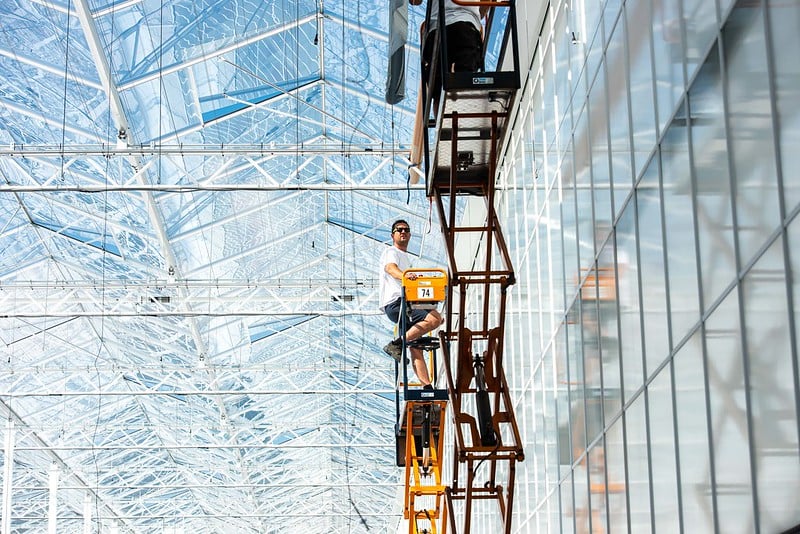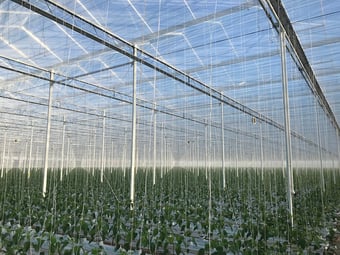Before discussing maintenance, prevention is always better than cure. It is important that climate screens are controlled properly by the grower and the climate computer. For example, suppose ventilation windows are open during high wind speeds. In that case, air currents can create tension on the fabric to such an extent that there is a risk of damage to the screen material and the installation. It is therefore important to always ensure that you consider the right safety measures in the control settings of your climate computer.
Besides problems as a result of extreme weather conditions, your screen system can also malfunction as a result of other aspects that are causing holes and tears in the cloth, and gaps between screens. If the screens are not working correctly, it will affect your crop yield. Plants under areas that are damaged will lose the benefits usually provided by the screens – they will be exposed to colder temperatures or too much sun. Or perhaps there will be a loss of light, which can impact your production output negatively.
Dirty screens, holes, tears, and gaps in your installation can be caused by multiple factors. For example:
- Ventilation: Wind and air currents put pressure on the screens
- Extreme weather: Storms can cause damage to windows and the greenhouse roof. If screens are closed during a storm, broken glass can cause damage to the cloth, resulting in holes and tears. Therefore, always open your screens during storm conditions. Then, in case of strong winds or a storm, the cloth will not get damaged due to broken glass.
- Cleaning: High-pressure cleaners can damage the screens. During the crop cycle change, the greenhouse roof is often cleaned on the inside. If the screen is not fully open, high-pressure cleaners can damage the screen and the installation. In addition, it is also important to keep in mind that aggressive cleaning agents should not come into contact with the screen cloth.
- Maintenance: No proper maintenance on the screen and the installation. This may sound logical, but a lack of maintenance can make the damage even bigger.
Protect your climate screens with six-monthly maintenance
The solution to making sure your climate screens perform optimally is a six-monthly maintenance regime. This should start by checking on dirt, holes, and tears. Also checking the entire climate screen installation and drives is important. These installations are moving constantly and are regularly under pressure. For example, by lubricating drives and gears, you can make sure the screen installation fully opens and closes so you can avoid gaps between climate screens.
Also, make sure the total setup in your greenhouse is complete. In addition to horizontal screens, if you don’t have vertical screens for sidewalls yet, you should consider upgrading your climate screen setup. Strips and stripes between horizontal and vertical screens can close the systems totally, avoiding the loss of heat, resulting in saving significant amounts of money. For the best result, there must also be no gaps between the greenhouse ‘curtain’ and the horizontal screens.
Synergies in greenhouse systems are important
Motors and drives are a vital part of the climate screen installation. If there is no synergy with the screens, it can affect their performance by not closing them properly. For example, when gaps occur between different screens as the greenhouse structure expands with the sun's heat, a smart drive motor setup and screen system can ensure that this gap is closed simultaneously and synchronized. If the installation is driven and controlled properly, they will always close the screens successfully, controlling the amount of light and heat inside the greenhouse so that no crop is damaged, and no yield is lost. An example of such a drive solution is the Ridder SynCore.
In addition, a new generation of drive systems provides extra options for synchronized screening, predictive maintenance, and integrated position feedback. These Ridder SmartDrives are being installed in greenhouses this year, and will in time become the standard option for all greenhouses. The Ridder SmartDrive simplifies and accelerates the labor- and time-consuming installation process and the maintenance of ventilation and screen motors in greenhouse constructions. This is all thanks to the ingenious digital limit switch and advanced feedback from the integrated positioning unit. SmartDrives also have intelligent digital functionalities that enable the system to monitor the load and the use of the motors, which improves maintenance and the life of the installation. The predictive maintenance function will alert you when you need to carry out maintenance, improving the lifespan of your climate screens.
Replace your screens in time
Lastly, check the conditions of the screens cloth itself. Climate screens have become an indispensable part of achieving the ideal greenhouse climate and you use them every single day. If screens are left in place too long the quality simply goes down and among other things, causing less energy-saving or less light to reach your crops, which in turn can cost yield. It is best to change the cloth every 7 years to avoid this. When a change of or new screens is needed sooner rather than later, Ridder has a large stock of climate screens and can deliver quickly.
Request advice or watch the webinar
The climate in your greenhouse is one of the most important factors to ensure crop quality, the steadiness of production, and yield. Choosing the right climate screens and maintaining them properly will have a significant impact on the climate in your greenhouse.
Request a 1-on-1 meeting with our climate screen expert. Our experts can tell you more about how you can maintain your climate screens.
Or watch the recording of the webinar: 'Achieve a positive business impact with climate screens from Ridder'. In the webinar, we used real-life projects to show you how our clients received a positive return on investment after installing a climate screen.




